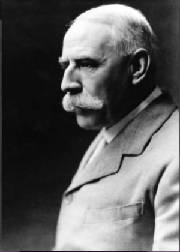|
The Quintessential Englishman

Edward Elgar was born in Broadheath, Worcester, on 2nd June 1857. His father owned a music-shop in Worcester, and was
also an organist and piano tuner. Edward grew up in a highly musical environment, and taught himself to play various instruments,
including the organ and the violin. His earliest compositions can be traced to his childhood - at age 12 he wrote incidental
music to a family play, The Wand of Youth.
During his youth, Elgar played the violin in local orchestras, formed a wind quintet with his brothers and friends, and
also became assistant organist to his father at St George's Church, Worcester. In 1879, he became bandmaster at a local lunatic
asylum, a position which gave him an opportunity to hone his compositional technique arranging and composing music for staff
concerts.
For the next decade he continued to compose for various local musical organisations, and also taught the violin. In 1889,
he married one of his pupils, Caroline Alice Roberts, against the wishes of her family. She was to prove a strong and faithful
wife, and assisted him greatly throughout his career.During the 1890s, compositions such as the secular cantatas The Black Knight (1889-92), King Olaf (1894-6), and Caractacus (1897-8), slowly began to expand his reputation outside his
native Worcestershire, gaining performances by Midlands choral societies. In 1899, he composed one of his most famous orchestral
works, the Variations on an Original Theme (or the Enigma Variations). Its first performance in London, conducted by Hans
Richter, was his first major success. The piece is dedicated to 'my friends pictured within', and each movement is a musical
representation of the personality and quirks of one of his friends. The extra-musical inspiration for the actual theme, or
the 'Enigma', continues to puzzle historians even to this day. The Sea Pictures for contralto and orchestra followed a few
months later, and was performed by Dame Clara at the Norwich Festival. In 1900, Elgar composed The Dream of Gerontius, his
finest religious work, in response to a commission for the 1900 Birmingham Festival. It was a failure at its first performance
due to lack of rehearsal, but subsequent performances at Dusseldorf in 1901 and at the Lower Rhine Festival the following
year were more successful. After hearing the work, Richard Strauss hailed Elgar as the leading English composer of the day. Elgar's Cockaigne (In London Town) Overture was successfully premiered in 1901, and in that year, his status as the quintessential
English composer was cemented with the composition of two Pomp and Circumstance Marches. Elgar was understandably enthusiastic
about the Trio section of the first March: 'I've got a tune that will knock 'em flat! .. a tune that comes once in a lifetime'.
King Edward VII was very taken with the tune, and eventually it became Land of Hope and Glory - England's 'other' national
anthem. Elgar was knighted by King Edward in 1904.
By this time, Elgar's music was being performed internationally by conductors such as Strauss, Steinbach, and Busoni.
The early 1900s saw the composition of the oratorios The Apostles (1903) and The Kingdom (1901-6), and the Introduction and Allegro for strings (1905), written for Professor
Sanford of Yale University. During a stay in Rome, Elgar began work on his Symphony No. 1 in A flat, which was first performed
in Manchester in 1908. Hans Richter, dedicatee of the symphony and the conductor who gave the premiere, remarked to the orchestra:
'Gentlemen, let us now rehearse the greatest symphony of modern times, written by the greatest modern composer - and not only
in this country'. The work was an immediate success and was performed internationally. The Violin Concerto followed in 1910, dedicated to Kreisler, and in 1911 he composed the Symphony No. 2 in E flat, dedicated
to the memory of King Edward VII. In 1912, he composed The Music Makers, an ode for contralto, chorus and orchestra based
on a poem by Arthur O'Shaughnessy, and the symphonic study Falstaff in 1913.
During the First World War, he composed several
patriotic works, music for the children's play The Starlight Express (1915), the Binyon settings The Spirit of England (1915-17),
and the ballet The Sanguine Fan (1917). In 1918 and 1919, he wrote his last four masterpieces - the Violin Sonata, the String
Quartet, the Piano Quintet, and the great Cello Concerto. These works show a turnaround in his style - they are much more
introverted and melancholy than the grandiose symphonies or marches. The Cello Concerto in particular expresses Elgar's despair
over the tragedy of the war.
In 1920, Elgar's wife died, crushing much of his will to compose. During the last 14 years of his life, he lived in retirement
as a country gentleman in Worcestershire. In 1928 he was made a Knight Commander of the Victorian Order, which gave him renewed
energy for composition. He began two large-scale projects, the opera The Spanish Lady, and the Third Symphony, both of which
were to remain unfinished. He made many recordings during the last few years of his life, most notably the Violin Concerto
with the 16-year-old Yehudi Menuhin. In October 1933, he discovered that he had a malignant tumour, and died on 23rd February,
1934.
|
 |
|
@the BBC
Worcester and Hereford
where you live.

|
| . |
|
 |
|
|
 |
|
|
|

